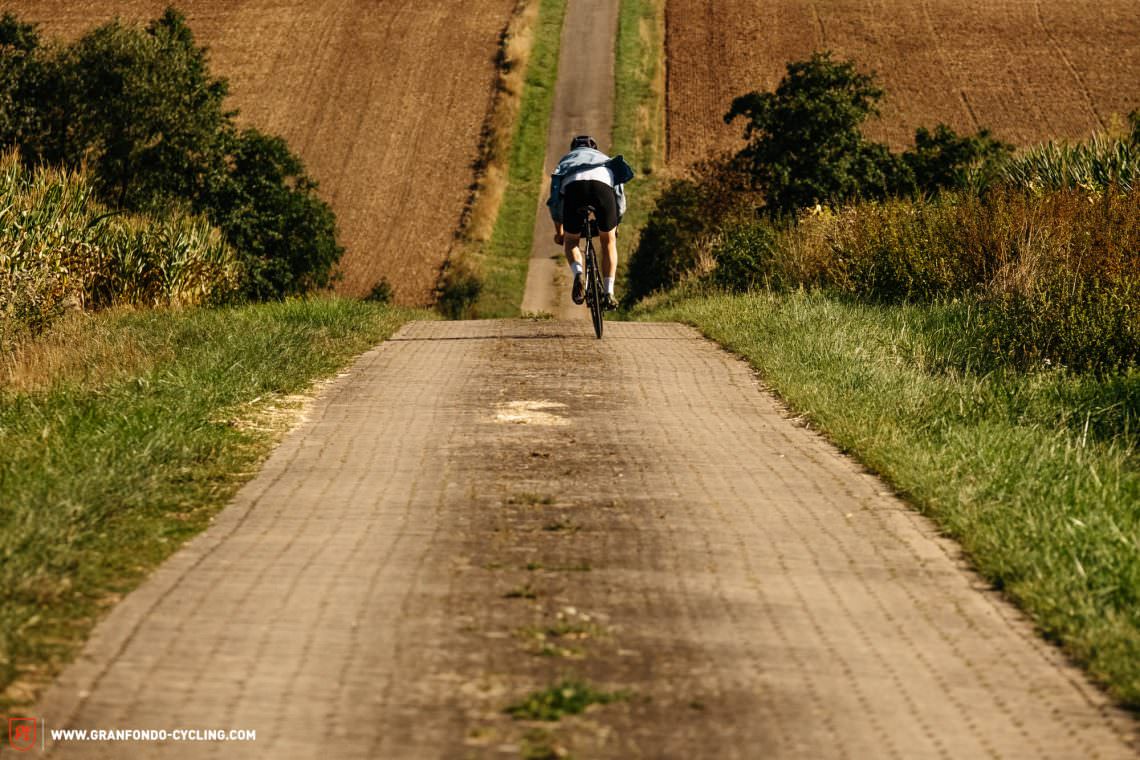The Standert Pfadfinder from the Berlin-based brand questions our previous perceptions of luxury. We had the exclusive test of this steel bike, riding it on and off road and getting to the bottom of what it’s all about.
Click here for an overview of the best gravel bike 2020 group test.

According to Standert, the Pfadfinder is the dictionary definition of an all-road bike designed to do a bit of everything. That was enough of a reason for us to include it as a left-field alternative in our group test. The steel frame is hand made in Taiwan from a mix of high-end Columbus tubing, with modern 12×142 mm spacing, mudguard mounts and 700 x 38C tire clearances that leave enough space for off-road tires. The Columbus carbon fork uses the 12×100 mm axle standard and is fitted to the frame via a high-end Chris King Inset 8 headset. The geometry of the Pfadfinder is designed to offer a sporty and agile ride and is most closely related to road bikes. One unique feature is that sizes 48, 50 and 52 are offered in a “Project Compact” geometry option that is designed to optimise the fit for smaller riders. You’ll find more information about this concept in the discussion we had with Sebastian Marks, the originator of the concept. Our test bike in size 58 weighs 9.12 kg and came equipped with a 2×12 SRAM Force eTAP AXS drivetrain, 140 mm SRAM Force HRD rotors front and rear, DT Swiss ER 1400 SPLINE DB21 wheels and 700 x 32C WTB Exposure tires. The cockpit of the € 4,299 steel steed was made up of a 420 mm Zipp Service Course SL-70 Ergo bar and 120 mm Zipp Service Course SL stem.

The Standert Pfadfinder in detail
Drivetrain SRAM Force eTap AXS
Gearing 46/33 t and 10-33 t, 2×12
Brakes SRAM Force HRD, 140/140 mm
Handlebar Zipp Service Course SL-70 Ergo, 420 mm
Stem Zipp Service Course SL, 120 mm
Seatpost Zipp Service Course SL Carbon, 20 mm offset
Wheels DT Swiss ER 1400 SPLINE DB21
Tires WTB Exposure 700 x 32C

The Zipp cockpit is stiff and precise. If you’re looking for more comfort you should consider a carbon bar.

The frameset will clear tires up to 700 x 38C. For better gravel performance you should make full use of the space available.

The sleek and tidy look of a steel frame doesn’t have an expiration date.

The Pfadfinder uses the T47 bottom bracket standard.
| Size | 48 PC | 50 PC | 52 PC | 54 | 56 | 58 | 60 |
|---|---|---|---|---|---|---|---|
| Seat tube | 480 mm | 495 mm | 510 mm | 530 mm | 550 mm | 570 mm | 585 mm |
| Top tube | 500 mm | 514 mm | 526 mm | 543 mm | 561 mm | 575 mm | 590 mm |
| Head tube | 98 mm | 108 mm | 118 mm | 131 mm | 148 mm | 164 mm | 177 mm |
| Head angle | 71.3° | 71.5° | 71.5° | 72.3° | 73.3° | 73.5° | 73.5° |
| Seat angle | 76.0° | 75.0° | 74.5° | 74.0° | 73.5° | 73.5° | 73.5° |
| Chainstays | 415 mm | 415 mm | 415 mm | 415 mm | 415 mm | 415 mm | 415 mm |
| Wheelbase | 979 mm | 983 mm | 991 mm | 997 mm | 1,000 mm | 1,015 mm | 1,030 mm |
| Reach | 368 mm | 370 mm | 375 mm | 383 mm | 390 mm | 400 mm | 441 mm |
| Stack | 520 mm | 530 mm | 540 mm | 555 mm | 575 mm | 590 mm | 605 mm |
The Standert Pfadfinder in review
The Standert reacts directly to your input, but in comparison to the lighter and stiffer carbon bikes in our tests takes a little longer to get up to speed. On the flats and downhill the bike generates a lot of speed and convinced our testers with its settled hold on the road. It’s solely the 140 mm disc rotors that can sometimes get overwhelmed on long descents. Broken up roads and compacted gravel are perfect for the Pfadfinder, though excursions off road aren’t an obstacle for either. However, as soon as you hit looser or more technical terrain such as rocks and roots, the bike starts to feel out of its depth due to the limited tire volume. Conversely, it’s very happy on the climbs, helped by the 46/33 t chainrings and 10-33 t cassette.

Higher volume tires for more comfort and off-road performance.


Stress-free exploration makes you too late for dinner.
The geometry reminds us very much of a road bike, with a sporty and stretched position. The road bike ergonomics and high-level of performance on compacted gravel are a rare combination and, frankly, a bit of a niche, but could offer the perfect characteristics for some riders. The front-end reacts quickly to direction changes while the short 415 mm chainstays ensure that the rear follows just as eagerly. Quick corners don’t pose any problem here. The high level of agility means that this bike isn’t the most stable and it demands attention and a weighted front wheel. Considering its intended application, the comfort offered by the bike is completely acceptable. However, in direct comparison to the Trek’s IsoSpeed system – admittedly an unfair competition – the limitations of the traditional steel construction become apparent.

Conclusion
The Standert Pfadfinder shines with its carefree ride on broken up roads and compacted gravel, with its honest, coherent concept. If you spend most of your time on asphalt but want to take the occasional shortcut along dirt tracks and forest roads, this is an agile bike with road bike genes and a sporty position. While steel will be a romantic proposition for many, the bike’s comfort and range of applications are slightly limited due to its traditional construction.
Tops
- balanced
- “Project Compact” geometries
- allure of steel combined with modern features
Flops
- limited braking performance due to small rotors
- average stability
Riding Characteristics
4Agility
- cumbersome
- playful
Stability
- nervous
- confident
Handling
- demanding
- balanced
Fun factor
- boring
- lively
Value for money
- terrible
- very good
For more info: standert.de
Click here for an overview of the best gravel bike 2020 group test.
All bikes in test: Argon 18 Dark Matter | Cannondale Topstone Carbon Ultegra RX | Canyon Grail AL 7.0 | Cervélo Áspero | Giant Revolt Advanced Pro Force | Kona Libre AL | Liteville 4-ONE MK1 | OPEN WI.DE. | Pivot Vault Team Force | ROSE BACKROAD GRX RX810 Di2 | Santa Cruz Stigmata CC | Specialized Turbo Creo SL Expert EVO | Standert Pfadfinder | Trek Domane SLR 9 eTap
No, it’s not about perfect race tracks, it’s about efficiency. Fast, fleet-footed and efficient – those who want to speed along high-speed passages need a defined and spritely bike that accelerates with ease and efficiency. Nevertheless, reliable components are important too. We interpret “Smooth tarmac” bikes as follows: Hard efforts at high speeds with a maximum efficient bike on a consistently well-paved road. Effort-joy ratio: 80:30 (not everything has to be 100%!)↩
… also known as bike riding. Broken-up roads in the hinterland, deadlocked gravel roads, loose surfaces – sometimes muddy, sometimes bone-dry. For this, it takes bikes with super all-round, handling and wearing qualities uphill and downhill. Effort-joy ratio: 50:50↩
If you want to use your bike almost every day, you usually do not need an extremely tuned racing machine. Solid components, which are able to cope with the rigours of continuous usage in any kind of weather, are part of the basic equipment. At the same time, the bike should have practicable details: integrated fenders/assembly options, luggage racks/attachment points and a light system or at least the option of installing bike lights. The position on the bike should be rather relaxed, the overall comfort high, so that the Afterwork Ride becomes a cure and not a curse. Effort-joy ratio: 30:70↩
You can find more info about our rating system in this article: Click here! ↩
Did you enjoy this article? If so, we would be stoked if you decide to support us with a monthly contribution. By becoming a supporter of GRAN FONDO, you will help secure a sustainable future for high-quality cycling journalism. Click here to learn more.
Words: Photos: GRAN FONDO-Team







